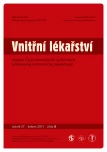Treatment of critical limb ischemia and diabetic foot disease by the use of autologous stem cells
Authors:
M. Dubský 1; A. Jirkovská 1; R. Bém 1; L. Pagáčová 2; V. Fejfarová 1; M. Varga 3; J. Skibová 5; Š. Langkramer 4; E. Syková 4
Authors‘ workplace:
Centrum diabetologie IKEM Praha, přednostka prof. MUDr. Terezie Pelikánová, DrSc.
1; Pracoviště laboratorních metod IKEM Praha, přednosta prof. MUDr. Antonín Jabor, CSc.
2; Klinika transplantační chirurgie IKEM Praha, přednosta prof. MUDr. Miloš Adamec, CSc.
3; Ústav experimentální medicíny AV ČR, v. v. i., ředitelka prof. MUDr. Eva Syková, DrSc.
4; Oddělení statistiky IKEM Praha
5
Published in:
Vnitř Lék 2011; 57(5): 451-455
Category:
Original Contributions
Overview
Aim:
The aim of our study was to assess safety and efectiveness of therapy of critical limb ischaemia by autologous stem cells and evaluation of potential adverse events.
Methods:
Fourteen patients were included into the study (11 men, 3 women, mean age 61.9 ± 9.6 years, mean diabetes duration 23.5 ± 11.1 years, mean glycated hemoglobin 6 ± 1 %). Eight patients were treated by bone marrow stromal cells, 6 patients by peripheral blood progenitor cells after stimulation by filgrastim. The suspension of stem cells was then applied into the muscles of ischemic limbs. We evaluated transcutaneous oxygen tension (TcPO2), subjective pain sensation assessed by Visual Analog Scale (VAS) and wound healing.
Results:
TcPO2 significantly increased in all patients from 10 ± 8.7 mm Hg before the treatment to 39.4 ± 9.5 mm Hg after 6 months (p = 0.0005) after stem cell therapy. We also observed significant area defect reduction and pain decrease during the follow-up period. Median of area defect was reduced from 4.3 (0.7 – 31.7) before the treatment to 0.06 (0 – 0.5) cm2 after 6 months from the treatment (p = 0.0078). Decrease in rest pain was observed in all patients, mean VAS decreased from 5.3 ± 1.8 to 1.1 ± 1.3 after 6 months (p = 0.002).
Conclusion:
Our study suggests that stem cell therapy of diabetic foot disease is an effective therapeutic option with no adverse events for patients with severe peripehral arterial disease. This treatment leads to increase of transcutanous oxygen tension, improves wound healing and decreases the rest pain.
Key words:
stem cells – diabetic foot – peripheral arterial disease – revascularization
Sources
1. Jirkovská A. Ischemická choroba dolních končetin u pacientů s diabetem: Konzervativní terapie. In: Jirkovská A (ed.). Syndrom diabetické nohy. Praha: Maxdorf 2006; 161-165.
2. Fadini GP, Agostini C, Avogaro A. Autologous stem cell therapy for peripheral arterial disease: Meta-analysis and systematic review of the literature. Atherosclerosis 2010; 209: 10-17.
3. Awad O, Dedkov EI, Jiao C et al. Differential healing activities of CD34+ and CD14+ endothelial cell progenitors. Arterioscler Thromb Vasc Biol 2006; 26: 758-764.
4. Timmermans F, Van Hauwermeiren F, De Smedt M et al. Endothelial outgrowth cells are not derived from CD133+ cells or CD45+ hematopoietic precursors. Arterioscler Thromb Vasc Biol 2007; 27: 1572-1579.
5. Matoba S, Matsubara H. Therapeutic Angiogenesis using Cell Transplantation (TACT) Study Investigators. Therapeutic angiogenesis for peripheral artery diseases by autologous bone marrow cell transplantation. Curr Pharm Des 2009; 15: 2769-2777.
6. Tateishi-Yuayama E, Matsubara H, Murohara T et al. Therapeutic angiogenesis for patients with limb ischaemia by autologous transplantation of bone-marrow cells: a pilot study and a randomized controlled trial. Lancet 2002; 360: 427-435.
7. Huang P, Li S, Han M et al. Autologous transplantation of granulocyte colony-stimulating factor-mobilized peripheral blood mononuclear cells improves critical limb ischemia in diabetes. Diabetes Care 2005; 28: 2155-2160.
8. Al Mheid I, Quyyumi AA. Cell therapy in peripheral arterial disease. Angiology 2009; 59: 705-716.
9. Attanasio S, Snell J. Therapeutic angiogenesis in the management of critical limb ischemia: current concepts and review. Cardiol Rev 2009; 17: 115-120.
10. Wahlberg E. Angiogenesis and arteriogenesis in limb ischemia. J Vasc Surg 2003; 38: 198-203.
11. Schaper NC. Diabetic foot ulcer classification system for research purposes: a progress report on criteria for including patients in research studies. Diabetes Metab Res Rev 2004; 20: S90-S95.
12. Gough A, Clapperton M, Rolando N et al. Randomised placebo-controlled trial of granulocyte-colony stimulating factor in diabetic foot infection. Lancet 1997; 350: 855-859.
13. Procházka V, Gumulec J, Chmelová J et al. Autologous bone marrow stem cell transplantation in patients with end-stage chronical critical limb ischemia and diabetic foot. Vnitř Lék 2009; 55: 173-178.
14. Dubský M, Jirkovská A, Bém R et al. Možnosti buněčné terapie v léčbě ischemické choroby dolních končetin u syndromu diabetické nohy. DMEV 2009; 12: 128-132.
15. Lawall H, Bramlage P, Amann B. Stem cell and progenitor cell therapy in peripheral artery disease. A critical appraisal. Thromb Haemost 2010; 103: 696-709.
Labels
Diabetology Endocrinology Internal medicineArticle was published in
Internal Medicine

2011 Issue 5
Most read in this issue
- Morbus Ormond (idiopatic retroperitoneal fibrosis)
- Cardiotoxicity of cancer therapy
- Internal medicine and cognitive decline in seniors
- Disturbance of synthesis of cholesterol and its precursors in clinically serious conditions
